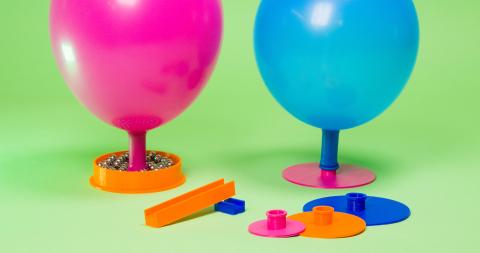Balloon Hovercraft - Power of Air

Explore how air is able to help us lift heavy things by reducing friction.
Description
Below, we present the main idea and equipment instructions of a hands-on activity called Power of Air, that is used at CERN Science Gateway in the framework of 30-45-minute-long workshops for student groups and families.
In this activity, participants investigate how balloon hovercrafts reduce friction and learn how this allows for heavy loads to be moved efficiently, emphasising the crucial role of engineering in unraveling the mysteries of physics. Just as engineering underpins many scientific discoveries at CERN, where solving engineering challenges is integral to probing the fundamental nature of the universe, participants gain invaluable experience in designing, building, and testing various configurations of their air pads to solve a series of challenges.
This simple air pad technology is also frequently employed at CERN. You can find a video showing how the CMS Experiment at CERN moves disks weighing 1400 tonnes here.
Material list
Here, we present the setup used at CERN Science Gateway. For the air pads, a 3D printer is required. You can find all the 3D-printing files here.
- 3D-printed air pads made of PLA plastic. You will need to print:
- 1x tiny.f3d
- 1x small.f3d
- 1x medium.f3d
- 1x large.f3d
- 4x long_neck.f3d
- Some balloons
- Some small weights (we use LEGO Duplo)
- Different surfaces to test (table, carpet, ...)
Instructions
- Prepare all the material needed.
- Take an air pad and a balloon and show participants how to build their own hovercraft:
- Inflate the balloon.
- Twist the neck of the balloon so the air doesn't escape.
- Slide it onto the air pad.
- Untwist and let go.
- Let participants explore the different air pads on different surfaces. Do you notice any differences between the air pads? Does the surface matter?
- Challenge participants to try and put as much weight as possible on their air pads so they are still able to glide.
- Encourage participants to build more advanced systems using multiple air pads that are connected using any materials they can find to further increase the weight the air pads can carry.
- Encourage participants to attach strings to air pads, so they can pull and guide them along in a controlled fashion.
- Draw parallels to how this simple air pad technology is used in engineering to reduce friction and move very heavy objects and at CERN to move parts of detectors.
Ideas for educators
- During this activity, you can discuss the following with your classroom:
- Collaboration between engineers and physicists yields elegant solutions to diverse challenges, emphasising the importance of teamwork in problem-solving processes.
- Effective system design often results in seamless functionality, showcasing the significance of creativity and unconventional thinking in achieving successful innovations.
- Friction arises from microscopic irregularities on seemingly smooth surfaces, hindering motion by causing interlocking of tiny bumps upon surface contact.
- The implementation of an air cushion beneath the air pad contributes to friction reduction, showcasing how simple yet effective solutions, such as utilising air pressure, can facilitate the movement of heavy objects.
- You can also 3D-print a full CMS model and ask your students to use the balloon hovercraft to move the end-cap in a controlled fashion towards the rest of the CMS detector. You can find the 3D-printing instructions here.